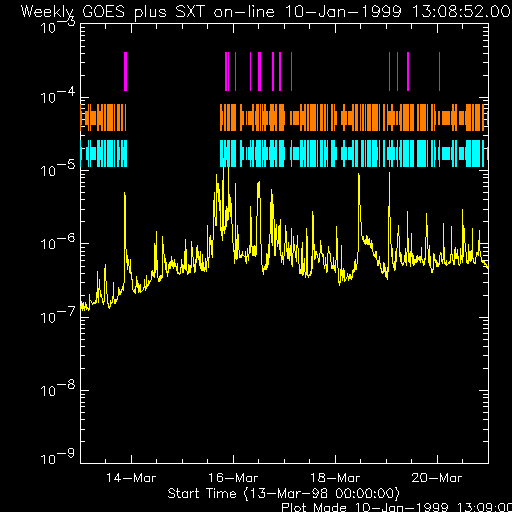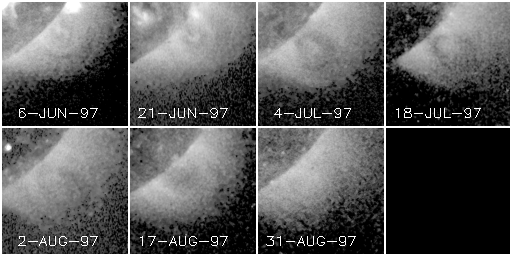
(Week 12, 1998)
The SXT instrument continued to operate without problems. The spacecraft suffered from a transient loss of star-tracker function, meaning that small roll errors occurred. This was due to ground support software. See the weekly operations report for details. The GOES time series for the current week (updates automatically):

In the display above, and you can click to enlarge it, the colored lines show the times of SXT images that currently are on line at ISAS. The purple lines show where Yohkoh entered flare mode. This sometimes (often?) does not happen when it should, especially if Yohkoh happens to be in orbit night! The scale is too compressed here to be able to see individual data, but the times of the individual images are actually being shown. Most of the gaps will be filled in when the NASA telemetry arrives. The lengths of the tick-marks show high and medium telemetry rates; the yellow line shows the GOES low channel flux. Since this is an expert audience, it can figure out the A, B, C, M, X levels without further help!
This week's science nugget is retrospective, which is not to say that this week did not have interesting items. See last week's material on interconnecting loops, for example.

Seven views of a southern-hemisphere filament cavity of 1997 as it passed the E and W limbs, with every other image flipped EW so that the eye can follow easily. Images are individual 5-sec exposures (AlMg filter) from the soft X-ray telescope (SXT) on board Yohkoh. In the first image E is to the left (normal orientation). During the front-side passages of the cavity, the filament could be seen clearly; the orientation almost exactly along a parallel of longitude probably makes these faint features visible at the limb because of the greater projection depth. The limb appearance in early July lasted for three days, so that the structure was on the order of 45 degrees long. The structure itself was detectable for three full rotations. It was exceptionally stable in spite of its appearance as a fully-formed cavity, sometimes thought to be the predecessor of a CME via a "tether-cutting" process.
The bright structure near the core of the cavity lies above the 10830 filament and on occasion shows transient loop-like parts, especially towards the beginning of the sequence. This as-yet-unexplained phenomenon of a bright cavity core (or "chewy nougat," the term coined by Sam Freeland or Greg Slater perhaps) has only rarely been observed in the Yohkoh data, possibly because of the need for the right projection angle. We find this to be remarkable (a) because filaments are cold, and we find something hot instead; and (b) most people seeing a still image of this structure for the first time automatically think "plasmoid" and/or "eruption," which of course do not apply well here.